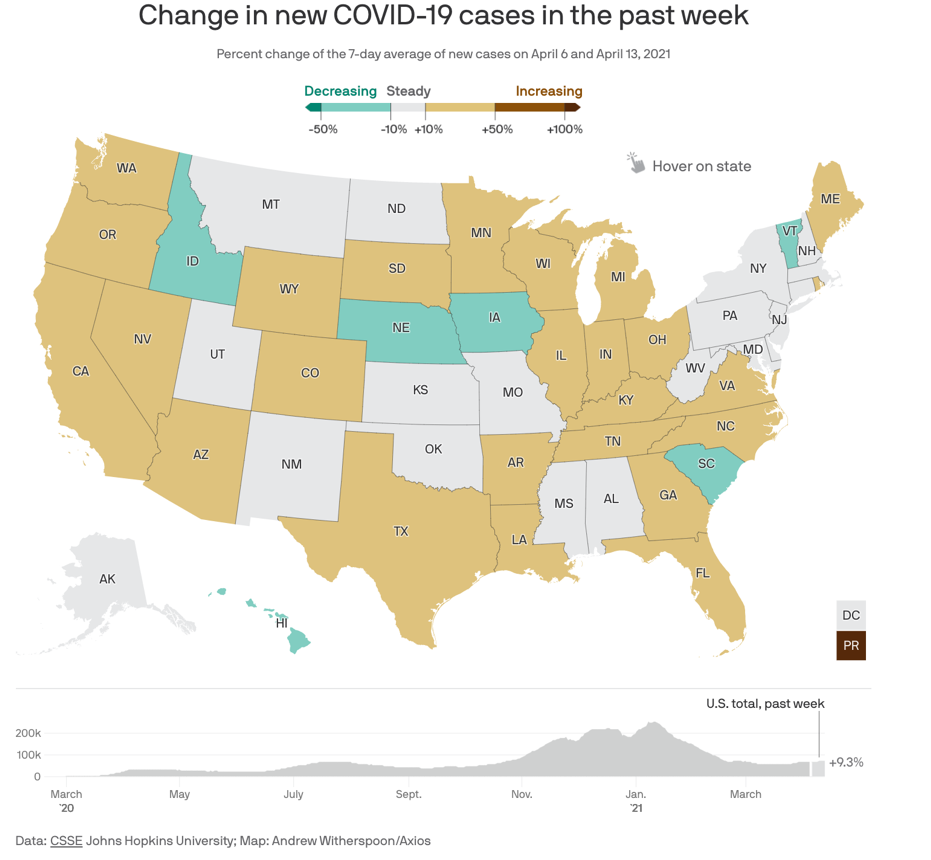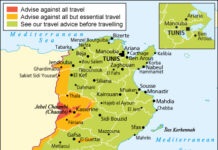 Covering COVID-19 is a daily Poynter briefing of story ideas about the coronavirus and other timely topics for journalists, written by senior faculty Al Tompkins. Sign up here to have it delivered to your inbox every weekday morning.
Covering COVID-19 is a daily Poynter briefing of story ideas about the coronavirus and other timely topics for journalists, written by senior faculty Al Tompkins. Sign up here to have it delivered to your inbox every weekday morning.
The Centers for Disease Control and Prevention says 5,800 Americans who have been fully vaccinated have gotten COVID-19. That means breakthrough cases represent significantly less than 1% of fully vaccinated people.
This lines up with two peer-reviewed studies published in recent weeks (study one and study two).
The breakthrough COVID-19 infections reported to the CDC were out of more than 75 million fully vaccinated individuals in the U.S., occurring in less than 0.008 percent of fully vaccinated people. Hospitalizations have occurred in 0.0005 percent of all full vaccinations and deaths in almost 0.0001 percent.
“To date, no unexpected patterns have been identified in case demographics or vaccine characteristics,” the CDC said. Here is what the data does show:
- About 40% of the infections were in people older than 60, but breakthrough cases occurred among all age groups.
- 65% were women.
- 29% of the breakthrough infections were reported as asymptomatic.
- 7% of people with breakthrough infections were known to be hospitalized.
Keep in mind that while the vaccines do not guarantee 100% protection, they greatly reduce your chance of getting sick. Even for those who get infected after vaccination, very few become severely ill. NPR reports:
“It would also appear the rare infections that occur are (generally) less severe, so it would also protect us against severe disease, which is great,” says Dr. Francesca Torriani, an infectious disease researcher at the University of California San Diego, who has studied breakthrough infections among health care workers.
Pfizer CEO Albert Bourla says recipients of his company’s vaccine will “likely” need a third dose between six to 12 months after full vaccination and an annual shot after that. But that is not yet a firm recommendation. The booster might be necessary to ensure that you are protected against variant virus strains, which are becoming the dominant strains in some places.
Moderna reports that its vaccine, like Pfizer’s, will protect you for at least six months, and maybe longer.
“Updated cases show continued strong efficacy, including greater than 90% against cases of COVID-19 and greater than 95% against severe cases of COVID-19, with approximately 6 months median follow-up post dose 2,” the company said in a statement.
Moderna is not saying yet whether you will need a booster shot to protect you against variant viruses.
Dr. Christopher Murray, the director of the Institute for Health Metrics and Evaluation at the University of Washington in Seattle, has been at the forefront of modeling where the pandemic is heading for more than a year. A recent review of IHME’s forecasts from a year ago shows them to have been “incredibly accurate.” So when Murray speaks, it is worth paying attention.
His “optimistic” forecast is that daily COVID-19 deaths will rise a bit in the next month, then decline from May through August. Then he delivers the bad news.
He predicts “a considerable surge will occur over next winter” because the new variants are more transmissible and people will likely relax social distancing and mask-wearing.
The IHME predicts that the percentage of Americans who usually don masks will decline from 73% today to 21% by Aug. 1. By July 1, he says, we will be back up to 1,000 COVID-19 deaths a day.
He says the United States may record 618,523 deaths from COVID-19. And, “Deaths could be as high as 696,651 if mobility among the vaccinated returns to pre-pandemic levels,” the institute forecasts.
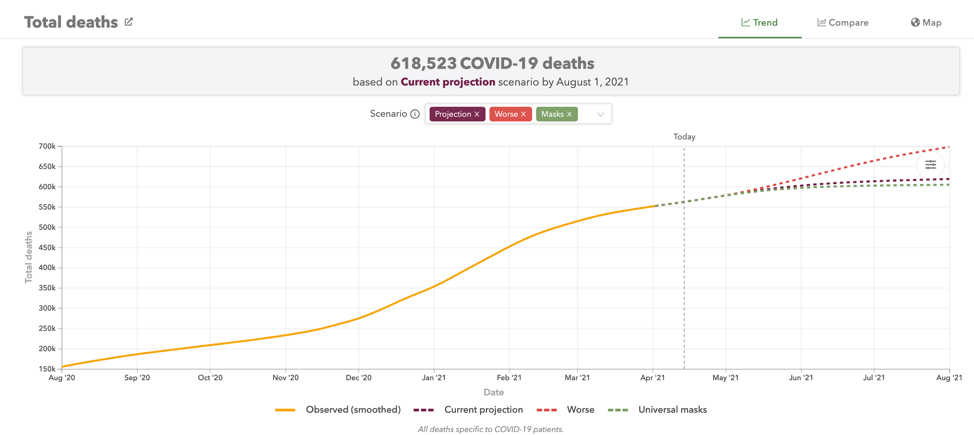
(Institute for Health Metrics and Evaluation)
Murray says the risk of a “double surge” — an increase in COVID-19 cases at the same time the seasonal flu sets in — could be higher this year than last flu season. The reason, he says, is that during the last flu season, we were still fairly socially distanced and wearing masks. By late 2021, he says, we may well have let up on both and could therefore expect more seasonal flu cases.
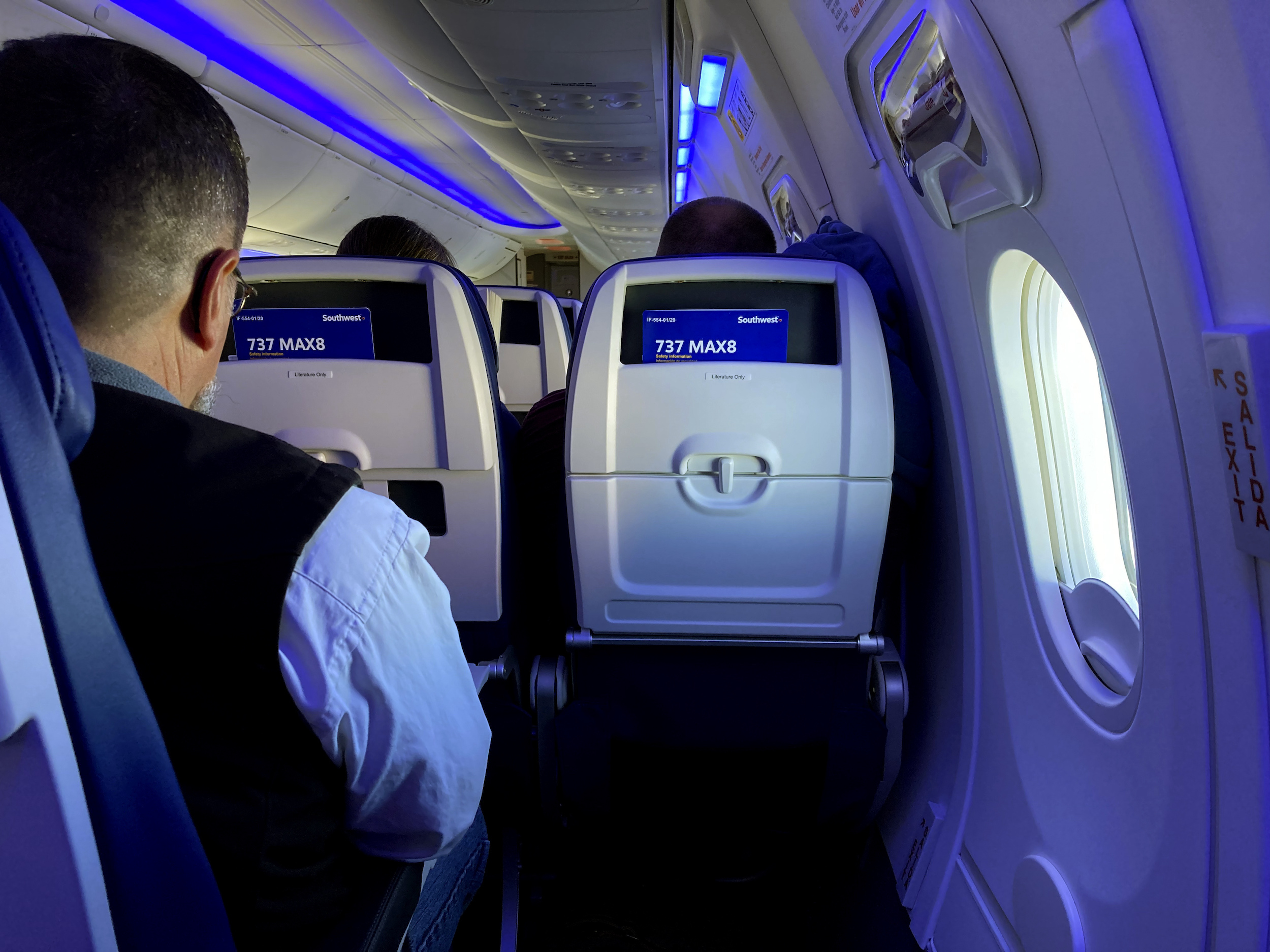
Passengers on a Southwest Airlines Boeing 737 Max 8 flight prepare to land at Houston’s Hobby airport March 20, 2021. (AP Photo/Charlie Riedel)
The latest data shows people are searching for airfare deals at exactly the same moment that fares are rising. As the New York Times points out:
Flights have not proved to be a significant source of coronavirus spread; an article in JAMA identified only 42 instances worldwide as of October. Public health officials are contributing to that sense of safety: Early this month, the Centers for Disease Control and Prevention said vaccinated people could safely travel in the United States without testing or quarantining.
I truly do not know if it helps for me to keep reminding you that vaccines alone will not control the pandemic. Look at this Axios map and you can see that this has not been a good week.
Cases rose in more than half the country, with overall cases up 9% from the week before.
Thirty-eight states have reported an increase during the past week in the number of people hospitalized with covid-19, the disease caused by the virus, according to a Washington Post analysis of data provided by the Department of Health and Human Services.
But the national statistics don’t capture the intensity of the coronavirus emergency in the hotspots. Michigan reported more than 10,000 new infections on Tuesday alone. The state on Wednesday reported an average of 46 deaths a day, up from 16 a month earlier.
Along with Michigan, 32 other states have registered increases in infections in the past two weeks, including all the states along the Great Lakes, from Wisconsin to Pennsylvania. Minnesota and South Dakota are also up, making the Upper Midwest the major regional center of the spring wave. If there’s a single broad trend, it’s that the northern tier of the country is generally faring worse than the southern — for the moment.
Other regional hotspots include Maine and New Hampshire in northern New England; Delaware and Maryland in the Mid-Atlantic; Arizona, Colorado and Nevada in the Mountain West; and Oregon and Washington in the Pacific Northwest.
“In a nutshell, the increasing trend is concerning — covid-19 is clearly alive and well,” said Jeffrey S. Duchin, health officer for Seattle and King County. “It’s causing a large number of illnesses in young and middle-aged adults right now.”
I want to pass along this non-COVID story that is too important to bury.
The CDC’s data runs a year or so behind the calendar, so this is 2019 data, but it is the best we have. The CDC reports:
- 2.5 million reported cases of chlamydia, gonorrhea, and syphilis, the three most commonly reported STDs in 2019.
- A nearly 30% increase in these reportable STDs between 2015 and 2019.
- The sharpest increase was in cases of syphilis among newborns (i.e., congenital syphilis), which nearly quadrupled between 2015 and 2019.
“Less than 20 years ago, gonorrhea rates in the U.S. were at historic lows, syphilis was close to elimination, and advances in chlamydia diagnostics made it easier to detect infections,” said Raul Romaguera, DMD, MPH, acting director for CDC’s Division of STD Prevention. “That progress has since unraveled, and our STD defenses are down. We must prioritize and focus our efforts to regain this lost ground and control the spread of STDs.”
The CDC lists demographic groups that see increased rates:
The burden of STDs increased overall and across many groups in 2019. But it continued to hit racial and ethnic minority groups, gay and bisexual men, and youth the hardest.
In 2019 STD rates:
- For African American or Black people were 5-8 times that of non-Hispanic White people.
- For American Indian or Alaska Native and Native Hawaiian or Other Pacific Islander people were 3-5 times that of non-Hispanic White people.
- For Hispanic or Latino people were 1-2 times that of non-Hispanic White people.
Gay and Bisexual Men
- Make up nearly half of all 2019 primary and secondary syphilis cases.
- Gonorrhea rates were 42 times that of heterosexual men in some areas.
Young People Aged 15–24 years
- Make up 61% of chlamydia cases.
- Make up 42% of gonorrhea cases.
COVID-19 has robbed some people of their sense of smell, so a new cookbook focuses more on texture to compensate. Architecture and design publication Hunker reports:
“In it, you’ll find a range of recipes that use ingredient combinations, along with textures and other sensory factors, that we hope will help you derive pleasure from food,” reads Life Kitchen’s description. “And we’ve excluded the ingredients we now know most people with COVID don’t fancy.”
The research for this work began by trying to help cancer patients learn to love cooking again. The recipes were tested on 300 people who have had COVID-19 and lost their sense of smell.
I just marvel at smart creative people who use their talents to make the world better.
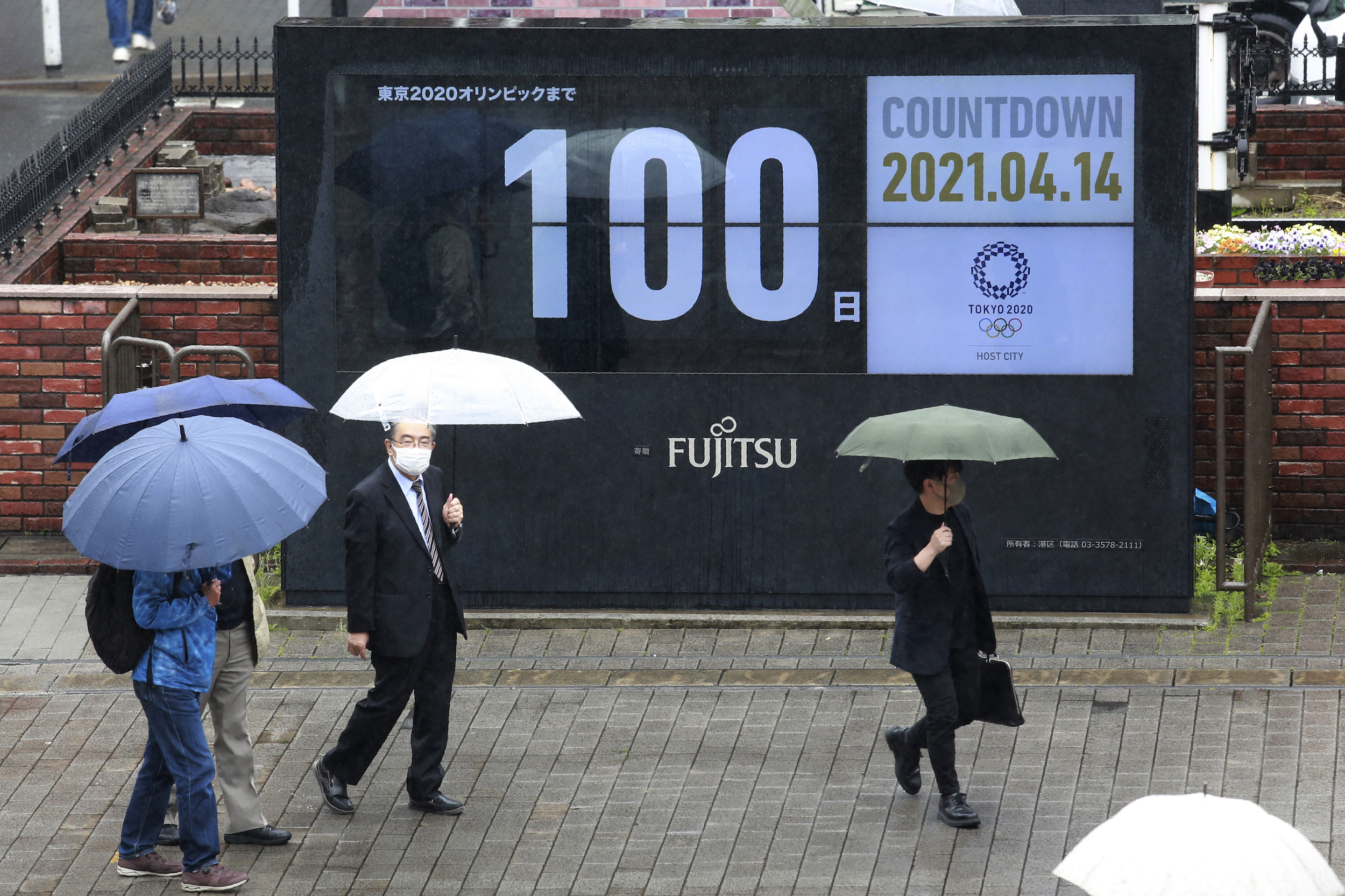
People walk by a countdown clock for Tokyo Olympic and Paralympic Games in Tokyo, Wednesday, April 14, 2021. (AP Photo/Koji Sasahara)
Japan is facing a potential fourth wave of COVID-19 infections with barely anybody there having been vaccinated. CNN reports:
While Prime Minister Yoshihide Suga reiterated Monday his pledge to secure 100 million vaccine doses by the end of June, so far Japan has only vaccinated about 1.1 million of its 126 million people — less than 1% of the population. Only 0.4% have received two doses.
International participants will need a negative Covid-19 test within 72 hours before they travel to Japan, where they will be retested, according to the Tokyo 2020 Playbook released by the International Olympic Committee (IOC) on February 21.
But according to the IOC document, athletes will not be required to quarantine for 14 days after arriving in Japan, unless they have breached the country’s Covid-19 precautions or potentially been exposed to the virus.
During the Games, participants will be “tested for Covid-19 at different intervals,” and all athletes and visitors will be assigned a “Covid-19 Liaison Officer.”
We’ll be back Monday with a new edition of Covering COVID-19. Are you subscribed? Sign up here to get it delivered right to your inbox.


